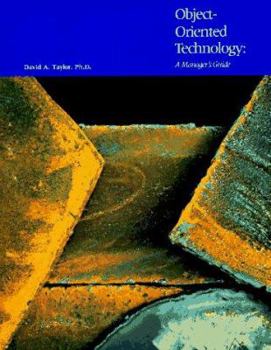Object-Oriented Technology: A Manager's Guide
This book addresses the issues facing the growth of object technology and to provide a glimpse into the future of this evolving paradigm. This description may be from another edition of this product.
Format:Paperback
Language:English
ISBN:0201563584
ISBN13:9780201563580
Release Date:January 1991
Publisher:Addison Wesley Publishing Company
Length:147 Pages
Weight:0.75 lbs.
Dimensions:0.3" x 7.0" x 9.0"
Customer Reviews
5 ratings
The title says it all, but programmers will benefit from this book also
Published by Thriftbooks.com User , 19 years ago
I gave a [highlighted] copy of this book to my boss. This was after reading it thoroughly several times. It is an excellent introduction to OO analysis and design issues. This won't replace Booch, Rumbaugh, UML and GoF Design Patterns, but it will get you started on the road to better software development. This is a primer, a bird's-eye-view. It can serve as a common vocabulary and basis of communication between non-technical and technical ppl. The best thing about this book is the strong integration of text, annotations and high-quality graphics. The ideas jump out of the page into your head. This book could be used as an introductory CS text in senior high school or freshman college.
The best concise introduction to object-oriented technology
Published by Thriftbooks.com User , 21 years ago
Note that, although the subtitle for this text implies Taylor's audience is solely managers, this book is suitable for anyone looking for a concise introduction to object-oriented software technology. Simply ignore some of the negative comments in other reviews regarding this book's viability in relation to early 21st-century software development - like almost every text written for an information technology audience, parts of this book, especially some of the predictions Taylor makes in the last chapters (at least in the first edition of the text), have been outmoded by lessons learned or shifts of focus in the past decade. Simply purchase the latest edition of texts such as this, especially if you are new to the topic - just remember that the new edition will undoubtedly be outmoded again in the future, but by that time you will probably have a handle on the topic and not need to refer back (at least very often) to an introductory text. What I like best about this text are the following: its conciseness (less than 150 pages) and compactness, its readability (very simple language - it is not written to impress by use of an extensive vocabulary), and its diagrams. As an individual who enjoys proper use of effective visual communication when technical topics are addressed, the simple diagrams are excellent - his use of the living cell as a model in understanding object basics like data and methods is ingenious, in my opinion. No code in this text, you say? If one is looking for an introductory OO text, why would he/she need code? Use of code would not only defeat the purpose of this text, but outmode it as soon as the next language of the day/week/month/year comes into fashion.
The best non-technical introduction to OOP
Published by Thriftbooks.com User , 22 years ago
Managers of software projects need to understand the fundamentals of object-oriented programming before they can effectively communicate with the developers they are managing. The purpose of this book is to provide an overview of object-oriented programming at the level of someone with a limited technical background. In that sense, it is an overwhelming success. I have taught object-oriented programming to experienced programmers for many years. When I first read this book in 1998, I was so impressed with some of the explanations that I have used modifications of them in my classes. There is no code in the book, most of the main ideas are demonstrated by diagram. Although the programming world continues to change at a rapid rate, this is still the best introduction to the principles of object-oriented programming that is available to the non-technical person.
Excellent, easy-learning introduction to Object Technology.
Published by Thriftbooks.com User , 25 years ago
This book gives a great introduction to object technology. It puts the technology in easy to understand terms and applies real-world business problems to objects.However, it does oversimplify how object technology is implemented and the real-world actual and realistic value that object technology may afford an organization.
Excellent introduction to the concepts of OO
Published by Thriftbooks.com User , 26 years ago
I found this book to be very helpful in understanding the concepts of object oriented programming. As I work in an industry that is related to technology, but not directly involved on a personal level with it (IT recruiting), I had an understanding of systems and languages, but nothing in depth. I have never been able to have someone explain the basics so clearly as Dr. Taylor does. I'd recommend this book to anyone who wants to learn more about OO, so long as they have a basic understanding of how computer systems and languages work and interact. He explains the concepts in an intelligent way that most non-technical people cannot, yet speaks in clear enough terms for laypeople that programmers often have difficulty with.





